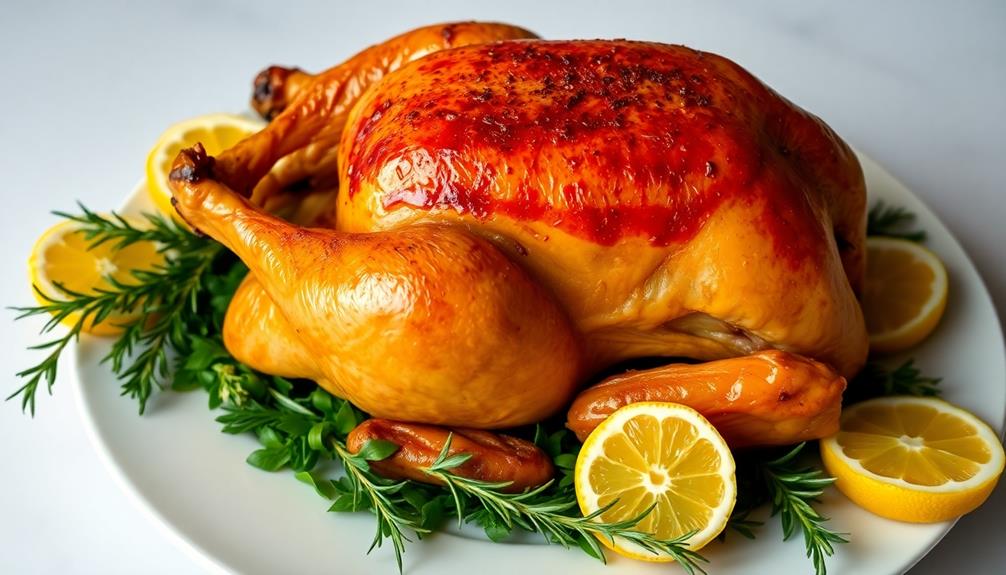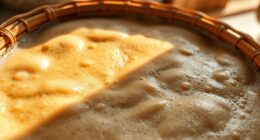Mastering the art of knife skills opens up a world of culinary possibilities! Start by holding the knife at the right angle and keeping your wrist straight to ensure precise, clean cuts. Then, glide the blade smoothly through the ingredients, maintaining a consistent cutting motion. Remember to stand with proper posture for maximum control. Once you nail the basics, try different techniques like chopping, dicing, and julienning to elevate your cooking. With regular practice, your knife skills will transform, boosting your confidence in the kitchen. And that's just the start – there's so much more to discover!
Key Takeaways
- Master the basic knife skills of chopping, dicing, and julienning to elevate your cooking through precise cutting and enhanced presentation.
- Develop proper knife handling techniques, including maintaining the correct angle, keeping a straight wrist, and using smooth, confident motions.
- Understand the importance of consistent cutting motion, proper posture, and a secure grip to ensure safety and control in the kitchen.
- Practice diverse cutting techniques, such as slicing, dicing, and julienning, to achieve varied textures and sizes for your culinary creations.
- Continuous improvement through regular practice, learning from mistakes, and experimenting with personal styles can lead to mastery of knife skills and increased culinary confidence.
History
The art of wielding a knife has a rich and storied history, dating back to the earliest days of human civilization. From the first sharpened stone tools used for hunting and gathering, to the sophisticated kitchen knives of today, the humble blade has played a central role in the evolution of human society.
As our ancestors progressed from nomadic lifestyles to the development of agriculture and settlements, the need for more specialized tools became apparent. Knives evolved, becoming sharper, more durable, and tailored for specific tasks.
Chefs in ancient civilizations, such as Greece and Rome, began to refine cutting techniques, laying the foundation for the intricate knife skills we admire today.
Throughout the centuries, the art of knife handling has continued to advance, influenced by the culinary traditions of diverse cultures around the world. From the lightning-fast julienning of Japanese chefs to the elegant chopping of French cuisine, the mastery of knife skills remains a point of pride and a crucial component of any skilled cook's repertoire.
Recipe
Preparing a delectable dish requires more than just throwing ingredients together. It's about mastering the art of knife skills, which can elevate even the simplest of recipes. In this recipe, we'll explore how to craft a mouthwatering meal while honing your culinary techniques. Developing these skills not only enhances your cooking but also promotes healthy eating habits from an early age, similar to how Nurture Life Finger Foods encourages healthy flavors for babies.
Knife skills are the foundation of any great cook's repertoire. From precise dicing to elegant slicing, the way you handle your knife can make all the difference in the final presentation and flavors of your dish. In this recipe, we'll guide you through the process, ensuring you develop the confidence and precision needed to tackle any culinary challenge.
- 1 lb boneless, skinless chicken breasts
- 2 tablespoons olive oil
- 1 onion, diced
- 3 cloves garlic, minced
- 1 red bell pepper, sliced
- 1 cup button mushrooms, sliced
- 2 cups diced tomatoes
- 1 cup chicken broth
- 1 teaspoon dried oregano
- Salt and pepper to taste
In a large skillet, heat the olive oil over medium-high heat. Use your newly honed knife skills to dice the onion and mince the garlic. Add them to the skillet and sauté until fragrant and translucent.
Next, slice the bell pepper and mushrooms, then add them to the pan. Sauté until the vegetables are tender. Carefully dice the chicken breasts, then add them to the skillet. Pour in the diced tomatoes, chicken broth, and oregano. Season with salt and pepper to taste.
Bring the mixture to a simmer and cook until the chicken is cooked through, about 15-20 minutes.
Serving this dish with a side of fluffy rice or fresh bread allows you to showcase your knife mastery. Remember, the key to exceptional knife skills lies in practice and patience. With time and dedication, you'll be slicing, dicing, and mincing like a true culinary artist.
Cooking Steps
Hold the knife at the right angle, keeping your wrist straight.
Slice through the food swiftly, maintaining a consistent cutting motion.
Remember to stand with proper posture and balance – this'll make the whole process much easier.
Step 1. Hold Knife at Correct Angle
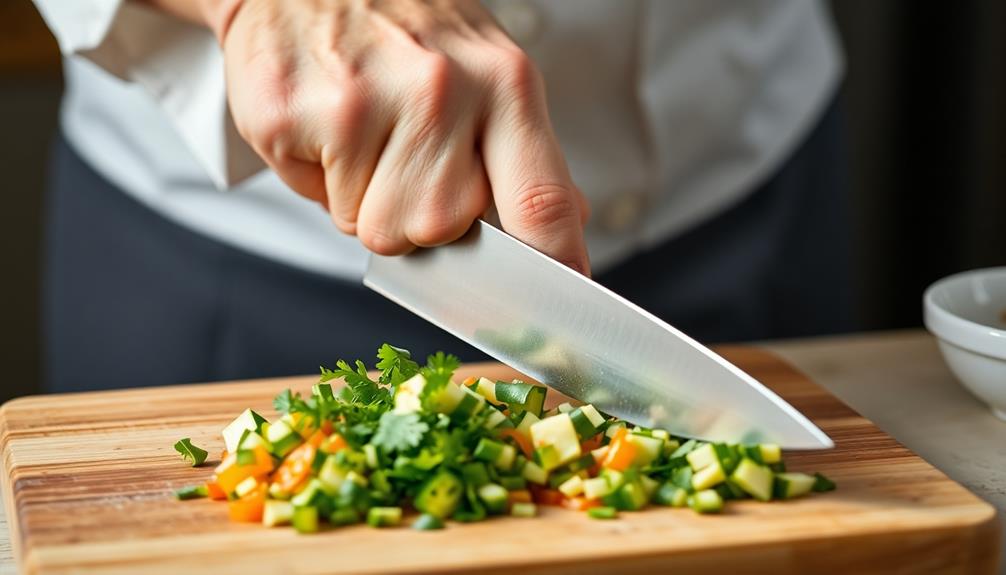
To properly handle a knife, you'll need to maintain the correct angle. When chopping, slicing, or dicing, it's important to hold the blade at a 20-30 degree angle relative to the cutting board. This allows the sharp edge to smoothly glide through the ingredients, creating clean, precise cuts.
Start by gripping the knife handle firmly with your dominant hand, with your thumb and index finger gently resting on the sides of the blade. Your other hand will guide the food, keeping your fingertips curled under to protect them.
Keeping the blade at the proper angle takes some practice, but once you get the hang of it, you'll be slicing and dicing like a professional chef!
The correct knife angle gives you maximum control and power, letting you efficiently prepare your ingredients. Remember to adjust the angle as needed for different tasks, like chopping herbs versus dicing onions.
With a little patience and persistence, holding your knife just right will become second nature.
Step 2. Keep Wrist Straight
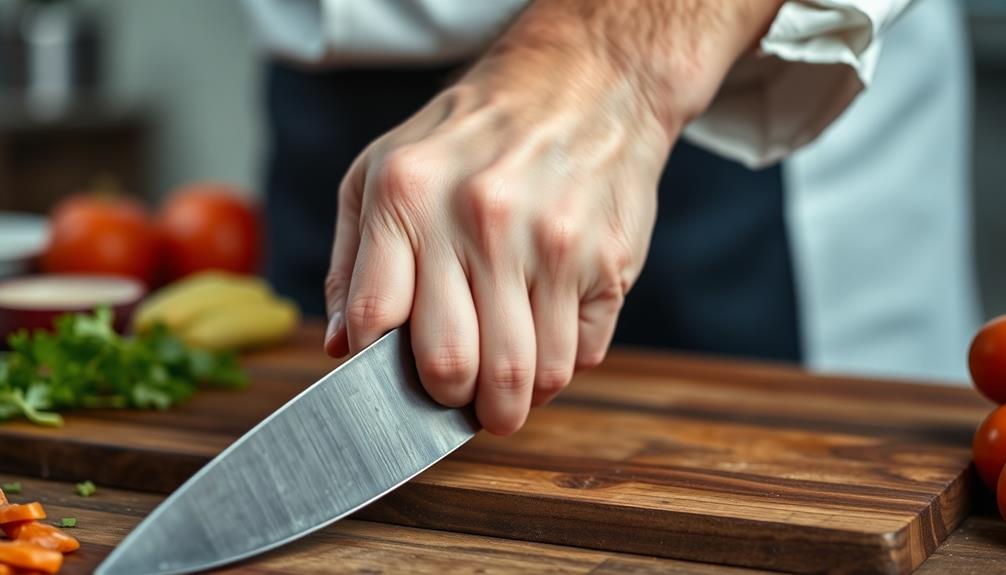
Maintaining a straight wrist is key when handling a knife. By keeping your wrist straight, you'll have more control and stability over the blade. This helps you make precise, clean cuts. Remember to avoid bending your wrist – that's a surefire way to lose control and potentially hurt yourself.
Instead, hold the knife firmly with your thumb and index finger, keeping your wrist in a neutral position. Imagine there's a straight line running from your forearm through your hand. This alignment gives you maximum power and precision.
As you chop, dice, or julienne, focus on maintaining that straight wrist. It may take some practice, but it'll soon become second nature.
The benefits are worth it! A straight wrist allows you to work quickly and efficiently in the kitchen. You'll be slicing, dicing, and mincing like a pro in no time. Plus, it's a safer way to handle sharp blades. So keep that wrist straight and get ready to master all your knife skills.
Step 3. Slide Knife Through Food Swiftly
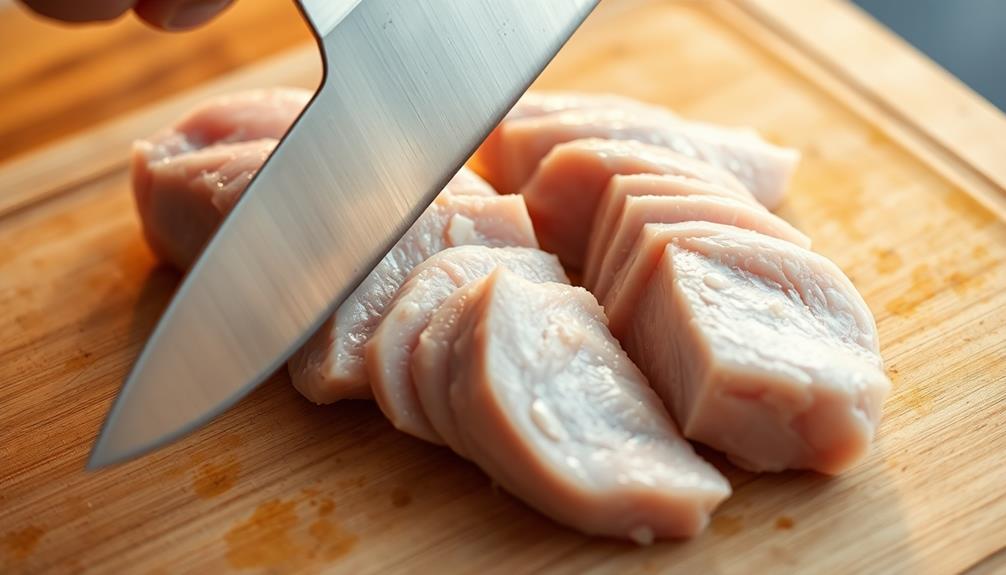
With a smooth, confident motion, slide the knife swiftly through the food. This technique takes a bit of practice, but when executed properly, it can make quick work of chopping, dicing, and julienning.
Keep your wrist straight and your fingers curled under, guiding the blade with your knuckles. Apply steady, even pressure as you glide the knife through the ingredients.
The key is to move the blade in a fluid, rhythmic motion, rather than hacking or sawing. This allows the sharp edge to do the work for you, slicing cleanly and efficiently.
As you gain speed and confidence, you'll be able to chop vegetables, herbs, and fruits in no time. The ability to slide the knife swiftly through food is an essential knife skill that will save you time and effort in the kitchen.
With practice, this technique will become second nature, helping you prepare meals like a professional.
Step 4. Maintain Consistent Cutting Motion
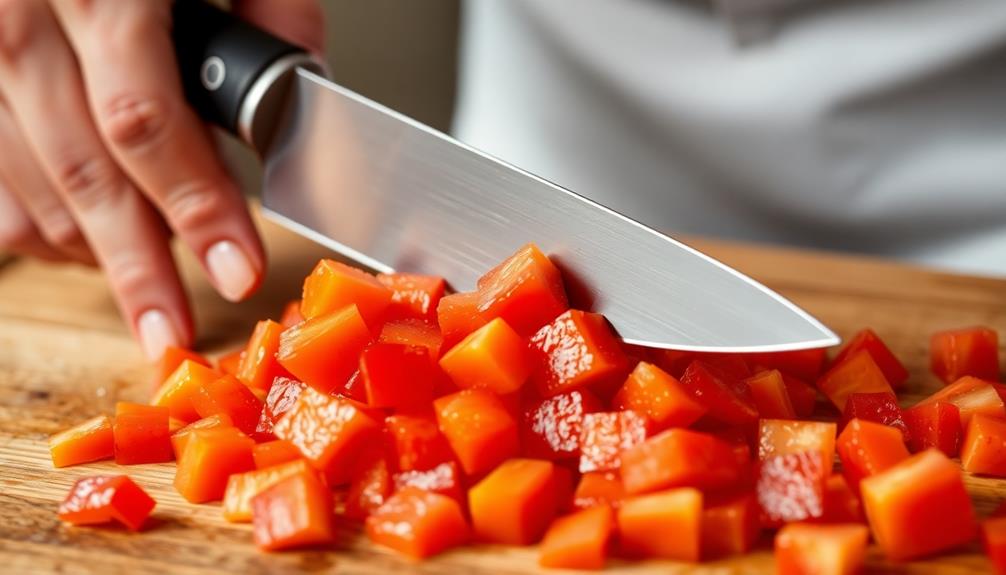
Keeping a consistent cutting motion is key to efficient food preparation. When slicing, dicing, or julienning, it's important to maintain a smooth, steady rhythm. This allows you to work quickly and accurately, avoiding uneven pieces or jagged edges. Envision your knife as an extension of your hand, guiding it with confidence through the food.
Begin each cut by firmly placing the knife's edge against the food. Then, apply gentle pressure as you glide the blade forward in a straight line. Keep your wrist and arm relaxed, using your shoulder and elbow to power the movement. Avoid chopping up and down, which can lead to an uneven, uncontrolled cut. Instead, focus on a fluid, side-to-side motion, maintaining the same speed and angle throughout.
Consistent cutting takes practice, but the rewards are worth it. Evenly sized pieces cook more uniformly, enhancing the final dish. Using proper knife techniques can also improve the overall presentation of your meal, making it as visually appealing as it is delicious. Beyond aesthetics, mastering your cuts allows you to choose the right technique for the right ingredient, from dicing delicate herbs to braising tough cuts to tender perfection. Over time, these skills become second nature, turning your kitchen prep into a seamless and rewarding process.
Plus, the satisfying "thwack" of the knife against the cutting board is music to any chef's ears. Stay focused, and let the blade do the work for you.
Step 5. Maintain Proper Posture and Stance

To maintain proper posture and stance, stand with your feet shoulder-width apart. Keep your back straight and your shoulders relaxed. Bend your knees slightly, distributing your weight evenly. This stable and balanced position will give you better control over the knife, allowing you to make precise cuts.
Always hold the knife with your thumb and forefinger grasping the blade near the handle, with the other fingers wrapped around the handle. Keep your elbow tucked in close to your body, not sticking out. This grip and position will help you guide the knife with accuracy and power.
As you slice, dice, or julienne, move your entire arm, not just your wrist. This maintains a smooth, controlled motion.
Remember to keep your eyes on the food, not the blade, for maximum safety and precision. With proper posture and stance, you'll be slicing, dicing, and julienning like a pro in no time!
Final Thoughts
Honing your knife skills is an ongoing journey, one that requires patience and dedication. As you continue to practice and refine your techniques, remember that each step brings you closer to becoming a true master of the kitchen.
Whether you're slicing, dicing, or julienning, the key is to stay focused, keep your movements steady, and always maintain a safe grip on the blade.
Don't be afraid to experiment and try new ways of handling your knife. Every chef has their own unique style, and finding what works best for you'll only enhance your culinary prowess.
Stay curious, be willing to learn, and don't be discouraged by the occasional slip-up. With time and practice, your knife skills will become second nature, allowing you to prepare meals with speed, precision, and confidence.
Frequently Asked Questions
What Is the Best Way to Sharpen a Dull Knife?
To sharpen a dull knife, use a sharpening stone or electric knife sharpener. Regularly honing the blade with a sharpening steel can also help maintain its edge. With a sharp knife, you'll slice and dice with ease.
How Do I Safely Store My Kitchen Knives?
To safely store your kitchen knives, use a knife block or magnetic strip. Avoid throwing them in a drawer, as that can dull the blades and pose a safety hazard. Keep them out of reach of children.
Can I Use a Serrated Knife for Chopping Vegetables?
You can use a serrated knife for chopping vegetables, but it's not the best choice. Serrated knives are better suited for slicing bread or tomatoes. For chopping veggies, a chef's knife or cleaver would be more effective.
How Do I Clean and Maintain My Chef's Knife?
You should hand-wash your chef's knife with warm soapy water, dry it thoroughly, and store it safely in a knife block or sheath to maintain its sharp edge. Regularly hone the blade to keep it in top condition.
What Are the Common Mistakes to Avoid When Using a Knife?
When using a knife, avoid common mistakes like holding it improperly, applying too much pressure, cutting towards your body, and rushing through tasks. Take your time, use proper technique, and stay focused to ensure safe and effective knife use.



